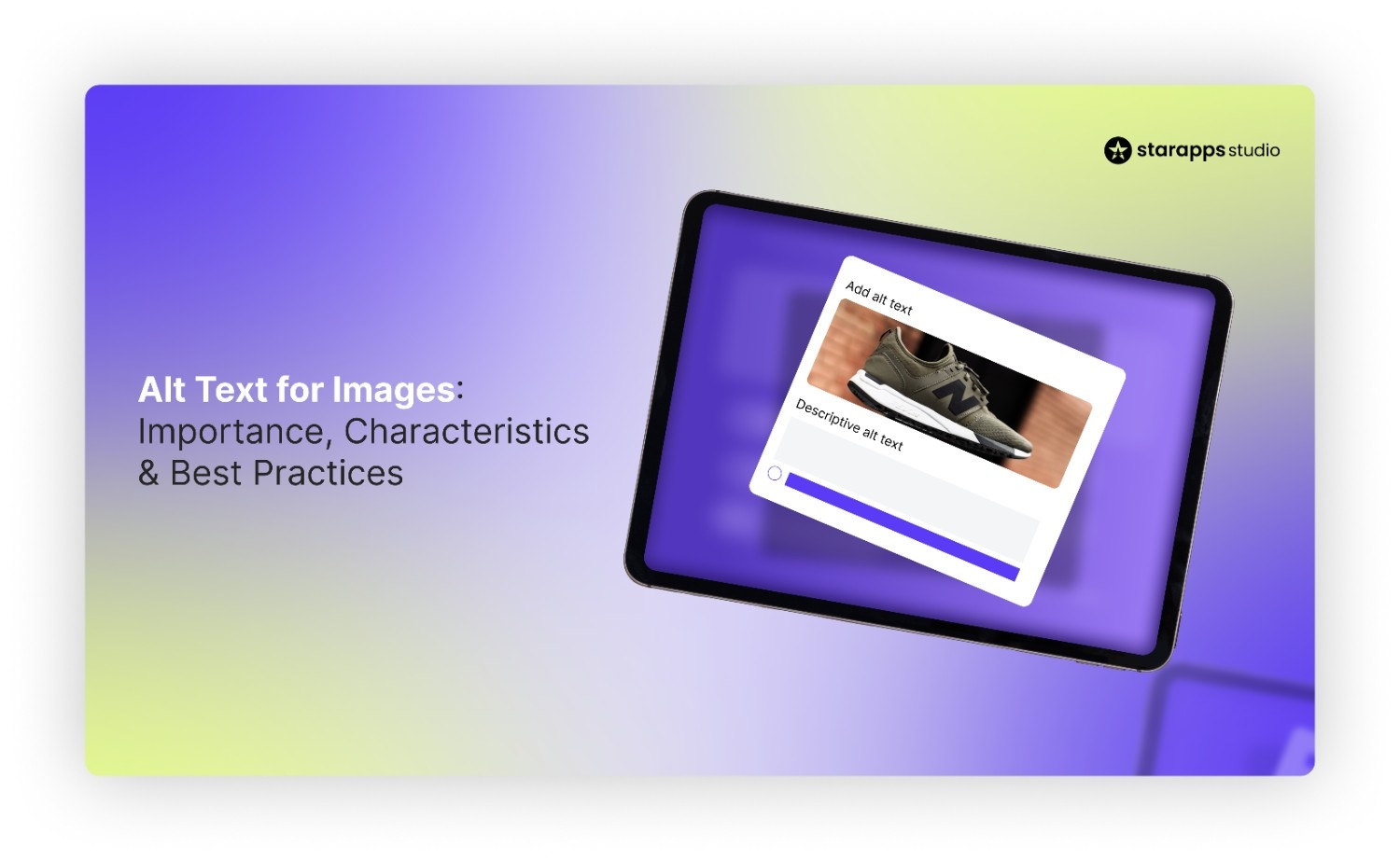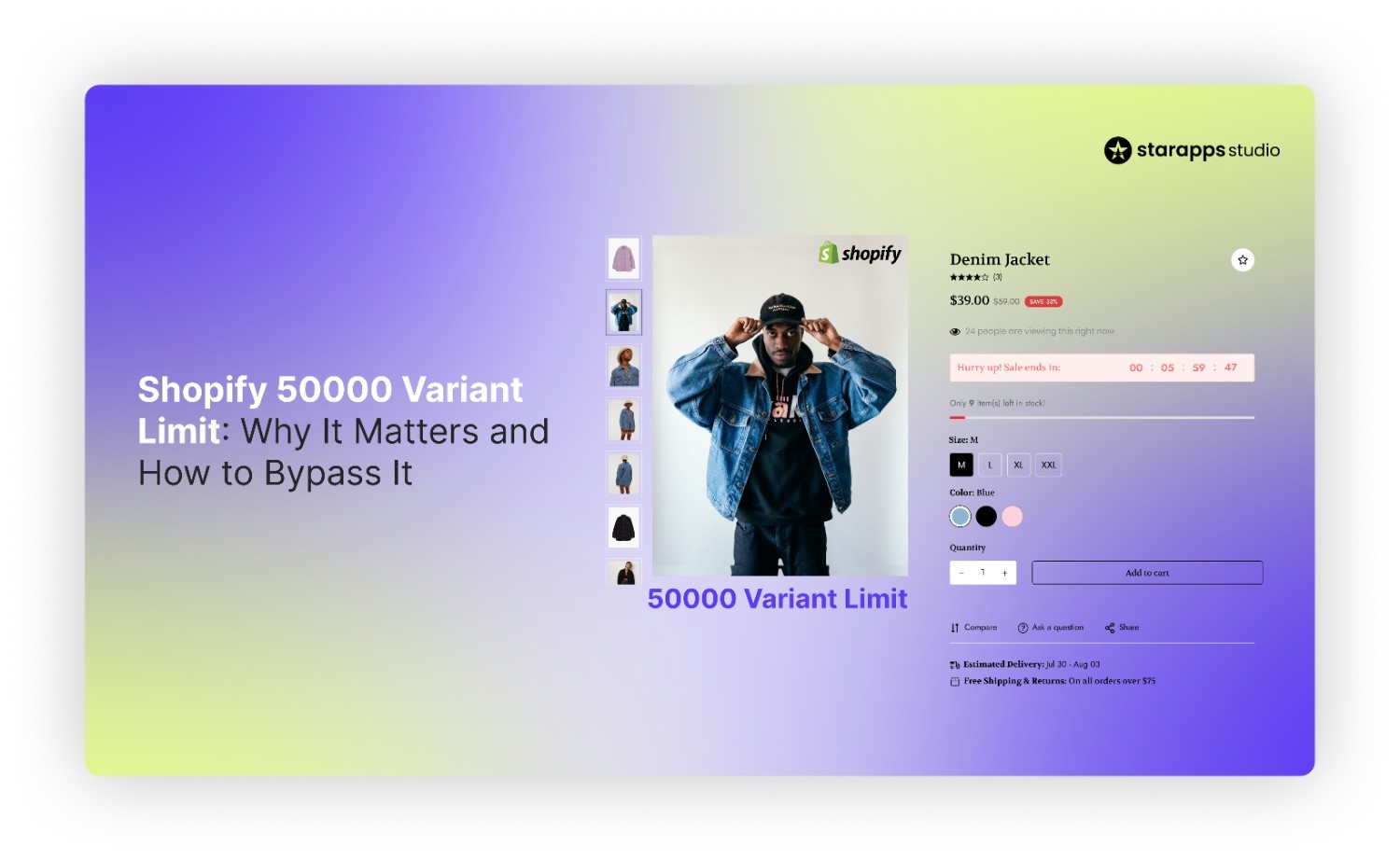
Learn how to display different text for Shopify variants using metafields, code, or apps to show the right info for each product option.
TL;DR
Shopify variants often require different text when options like size, material, or model include unique details, such as fit notes, shipping rules, or compatibility information. Shopify doesn’t support this out of the box, but you can solve it using variant metafields, custom code, or tools that sync text with each selection. Once set up, it's essential to write concise and consistent content, define fallbacks for empty fields, and review how the text appears across different devices. Managing this well helps customers obtain the exact information they need without having to scan through irrelevant product details.
75% of consumers now judge brands based on the availability of product information when shopping online. When key details are missing or unclear, especially for products with multiple options, customers lose confidence and walk away.
Shopify allows you to group product variants, such as color, size, or material, under a single product page. While this keeps your catalog organized, it can lead to confusion if each variant requires unique information. For example, a “Black – XL” hoodie might be made of a different fabric than the “White – M” version, or a larger size might ship separately.
That’s why your Shopify variants may need different supporting text, care instructions, fabric notes, compatibility warnings, or stock messages. Shopify allows you to display different text for each variant, but it requires a few extra steps to set it up.
This guide explains exactly how to do it using native Shopify features, custom code, or a visual app so your customers always see the right details for the variant they’re buying.
What are Shopify Variants?
In Shopify, a product variant is any version of a product that differs by one or more options, such as size, color, material, or style. For example, a single T-shirt listing might include five sizes and three colors, resulting in fifteen unique variants.
Variants are essential to a clean e-commerce experience. Instead of crowding your store with separate listings for each option, variants let customers choose what they need from one place. The variant system also ensures better inventory control, consolidated reviews, and easier catalog management.
Why You Might Need Different Text for Each Variant?
Although the product is shared, not every variant has the same properties. One variant might use a different fabric, ship from a different warehouse, or require special care instructions. In these cases, showing the same text across all variants can mislead customers.
One common workaround is listing all variant details in the main product description. But this forces customers to scan through extra content, most of which may not apply to the selected option. It clutters the page and makes it harder for users to find the information that’s actually relevant.
This is where variant-specific text becomes important. For example:
- A “White” shirt might say “100% Cotton, Made in India”
- A “Black” shirt might show “Polyester Blend, Imported”
- A “Size XXL” might come with a note: “Ships separately due to packaging.”
Example: Variant Text Behavior on Nomad
On Nomad Goods, selecting different variants of the Rugged Case triggers visible changes in text based on the chosen device model.
For example:
- Choosing iPhone 16 Pro Max displays a “No Longer Available” message.

- Switching to iPhone 15 Pro Max shows “Overstock Sale: 30% Off” and updates the variant label to “iPhone 15 Series.”

These messages appear directly on the product page without needing to reload or navigate away.
This is a working example of variant-specific messaging applied to stock status, labels, and promotional tags, all of which are controlled by the selected variant.
While Shopify lets you define variants easily, displaying different text per variant on the storefront takes a few extra steps. You can do this using metafields, JavaScript, or third-party apps, which we’ll cover next.
How Do You Add Different Text for Shopify Variants?
Shopify doesn’t show different text per variant by default, but you can make it happen in three ways:
- Using metafields to store and display text per variant (no coding required)
- Adding custom code to your theme (for advanced control)
- Using apps that let you manage variant-specific content visually
We’ll walk through each of these approaches, starting with the easiest: using metafields and Shopify’s Theme Editor.
Option 1: Display Variant Text Using Shopify Metafields (No Code)
If you’re using a 2.0 theme like Dawn, you can display unique text for each variant using meta fields without editing any code.
Step 1 – Create a Variant Metafield
- Go to Shopify Admin > Settings > Custom Data > Variants
- Click “Add definition.”
- Name it something like variant_description
- Choose Single-line text or Multi-line text as the content type
- Save
This creates a field where you can store unique text for each variant.
Step 2 – Add Text to Each Variant
- Open any product with variants
- Scroll down to each variant’s Metafields section
- Enter the relevant text (e.g., “White – 100% cotton” or “Ships in 2 days”)
- Save changes
You can also bulk edit variant metafields using the Bulk Editor in Shopify Admin.
Step 3 – Display Variant Text in Your Theme
- Go to Online Store > Themes > Customize
- Open the Product template
- Add a Text block or Custom Liquid block near the variant selector
- Click “Insert Dynamic Source” and select your metafield (variant_description)
- Save and preview
Now, when a customer selects a variant, the corresponding text will appear automatically, without any code edits.
Option 2: Add Variant-Specific Text via Custom Code
For stores that need more flexibility than what the Theme Editor offers, you can use custom code to show different text based on the selected variant. This method is ideal if you're using a custom theme or want to fully control how and where the text appears.
How It Works
You’ll need to:
- Output each variant’s text inside the HTML using Liquid and tag it with its variant.id
- Write a small JavaScript snippet that listens for variant selection changes
- Show or hide the matching text block dynamically as customers select different options
This method supports text pulled from variant metafields or even hardcoded content, giving you layout freedom not possible with Theme Editor blocks.
When to Use This
- You want to style or place the text outside Shopify’s default blocks
- Your theme doesn’t support dynamic binding for variant metafields
- You're comfortable editing Liquid and JavaScript or working with a developer
Option 3: Use a Shopify Integration – Variant Descriptions King by StarApps

If you want a no-code solution that gives you full control over variant-specific content, Variant Descriptions King by StarApps offers a purpose-built tool for the job.
This app lets you:
- Add different product descriptions for each variant (e.g., size info, color material, care instructions)
- Display these descriptions inside collapsible tabs or accordions.
- Automatically switch the visible content when a variant is selected.
- Show variant-specific info not just on product pages, but also in sections like FAQ, Returns, or Shipping tabs.
You can use it directly from the Shopify admin and customize how and where the content appears without editing your theme code or manually setting up meta fields.
It’s especially useful for stores that sell products with technical details, return exceptions, or material differences that vary across options.
Displaying different text for each variant can improve clarity and reduce customer confusion, but only if it’s managed well. Inconsistent formatting, repetitive content, or overloading each variant with too much detail can have the opposite effect.
Best Practices for Managing Variant Text
Variant-specific text aims to keep the buying experience clear and uncomplicated. Whether you're using metafields, code, or an app, here are some key practices to follow when setting up and maintaining variant-level content.
1. Keep It Concise and Relevant
- Focus on the single detail that differs—e.g., “DSLR Compatible,” “Ships in 2 Days,” or “100% Cotton”, rather than rewriting whole paragraphs per variant.
- Short, targeted text helps customers make quick, confident decisions.
2. Maintain Consistent Formatting
- Use the same style structure for each variant (e.g., “Material: X — Care: Y”).
- Consistency helps with readability and builds a clean, polished look across your product catalog.
3. Use Fallbacks for Missing Text
- If some variants do not have a special note, consider displaying a default message like “Standard variant, no extra info.”
- In no‑code setups, use Shopify’s Theme Editor default value; in code-based setups, include a Liquid fallback.
4. Preview on Multiple Devices
- Make sure the dynamic text appears correctly on mobile, tablet, and desktop views.
- Bullet lists or tabs can collapse poorly on small screens, so test the layout fits accordingly.
5. Audit Variant Text Regularly
- Especially if your catalog changes frequently, set a monthly or quarterly review to remove outdated notes (like discontinued fabrics or limited-time promotions).
- Bulk editors or apps (e.g., Metafields Guru) can streamline these updates
6. Use Customer-Focused Language
- Speak in terms of benefits: e.g., “Lightweight & Breathable” instead of “Made of poly-cotton blend.”
- Avoid confusing technical terms unless your audience is technically savvy (e.g., camera model compatibility).
7. Be Wary of Too Many Variants
- Shopify allows up to 100 variants per product, but too many can overwhelm users.
- If you need more than 100, consider using apps or splitting a product into multiple SKUs
Conclusion
Displaying different text for each variant gives customers the clarity they need to make confident decisions, especially when products differ by material, size, compatibility, or availability. Whether you use metafields, custom code, or visual apps, variant-specific messaging helps reduce confusion, improve conversions, and create a smoother shopping experience.
If you want to skip manual setup and manage variant-level descriptions with ease, try Variant Descriptions King by StarApps, a purpose-built app to help you assign and display the right content for every option. Explore Variant Descriptions King on Shopify
FAQs
1. How do I show a unique description for each variant in Shopify?
To display different text for each Shopify variant, you can create variant-level metafields and connect them to your product template using the Theme Editor or Liquid code. This allows each variant to show its own message, such as material notes or shipping info, based on what the customer selects.
2. Can I use Shopify metafields to manage variant-specific text?
Yes. Shopify lets you define metafields for individual variants—ideal for showing different text like size guides, care instructions, or compatibility notes. These fields can be connected to your store's product page layout using dynamic sources in Online Store 2.0 themes.
3. Is it possible to display variant-specific descriptions without writing code?
Absolutely. If you're using a 2.0-compatible theme, Shopify's Theme Editor supports dynamic metafield bindings. This means you can show unique text per variant without touching any Liquid or JavaScript. It’s a no-code way to display different text per Shopify variant directly in your storefront.
4. What's the best way to scale variant-specific descriptions across many products?
For large catalogs, manual metafield entry can be time-consuming. Consider using a Shopify app like StarApps Variant Descriptions or Metafields Guru to bulk-manage content. These tools streamline how you assign and update variant-level text across multiple SKUs.
5. Does showing different text per variant help with conversions or SEO?
It does improve conversions by giving customers clearer, more relevant details. While Shopify doesn't index variant-specific text as separate pages, improving content relevance per selection can reduce bounce rate and abandoned carts—key indirect signals that benefit SEO performance.
6. Can I show different product descriptions in tabs or accordions for each variant?
Yes. With the right setup, you can display variant-specific text inside collapsible tabs or sections. This is especially useful for technical products or apparel, where details like care, sizing, or specifications change with the selected variant.
7. What happens if a variant doesn’t have any specific text?
If no text is set for a variant, you can use fallback logic in a Custom Liquid block or leave the space blank. It’s good practice to keep defaults consistent across variants, even if some don’t need special instructions. Apps often allow you to define default content as well.
Heading
End-to-end traceability
To ensure regulatory compliance, you must have a complete overview of your products from production to shipping. Book a demo to see how Katana can give you full visibility of your operations.





.png)
.png)